Between Â鶹´«Ã½Ó³»vintage stores like , , and brands like Coach not only rising in popularity again but dropping an all-denim collection, it's clear we've fallen down the rabbit hole and landed in the (2000s).
There is so much colour everywhere you look, which under regular circumstances I would be thrilled by, but as I witness the rise of jelly roll handbags, layering, and denim—oh so much denim—my excitement is tempered as I wonder, how long will this last?
As far as fashion eras go, the fever dream that was early 2000s style seemed relatively short-lived. The tiny pleated skirts and low-rise pants paired with high-rise thongs didn't even make it a full decade. Don't believe me? Try comparing the fashion in Mean Girls (2004) to Easy A (2010).
What is the longevity of the Y2K trend?
Cohesive time-period specific fashion once operated in much broader strokes and long-lasting style cycles but The oversaturation of social media influencers producing identical content also gives us a false sense of a trend or certain type of clothing being everywhere when in fact, in regular life, it is not.
It also works the other way around. Denim stopped appearing on the runway but in ready-wear, it never went out of style. The silhouettes have changed shape somewhat but the recent overcompensation of designers in the form of seems like a zealousness that can't continue in popularity for an extended period of time.
So as I contemplate spending the money to pick up a piece or two and hop on the trend's resurgence because it looks like so much fun, I also consider their longevity. After all, I'm trying to move away from disposable fashion consumption, another issue that social media is both contributing to and striving to fix.
It's also worth noting that what qualifies as Y2K is also up for debate as GenZ and social media stars claim the style as their own, both explicitly trying to replicate what Millennials wore in their misguided youth in an ironic way and creating elevated versions of outfits that gesture to the era rather than imitate it.
Is a slinky slip dress Y2K or 90s? If it's black and paired with vampy eyeliner and dark lipstick then it's 90s. If it's in some sort of neon shade like green or pink and paired with a butterfly clip and shimmery lip gloss then it's Y2K, but really it's a fine line.
The dark side of Y2K fashion
The specific body type required to 'pull off' Y2K style also threatens to unravel the work that has been done by body-positive and size-inclusive pioneers in fashion if we don't engage with it critically. There are plus-size influencers on social media styling the trend but the initial rise in Y2K fashion in conjunction with broader conversations about the toxicity of 2000s diet culture still feels like a contradiction. Especially given that many aspects of Y2K fashion were a weapon of said diet culture.
Lululemon is capitalizing on its Y2K roots by opening up its design vault to incentivize people to download their app. Once downloaded people can buy the limited-edition Throwback Astro Pant along with other pieces from 2000-2011 but what's left out of that conversation is how the pants were never made to fit people who didn't have flat stomachs and small hips. So much so that they would become too far or the waistband would roll down if it didn't have hip bones pointy enough to keep it in place, flat against the body.
How to move forward
My guess is that with the Y2K trend getting as much criticism as love, it will likely burn itself out soon enough. Perhaps certain elements, having been revived and improved upon by GenZ, can remain in the pantheon of fashion for years to come but estranged from its origins. That may be best course of action.
I hope it's the colour that sticks around, similar to what we've seen with the regency resurgence, not only would colour suit my personal style but as many fashion critics have remarked since the pandemic, colour is something that we have all returned to as comfort and a form of expression during bleak times.



